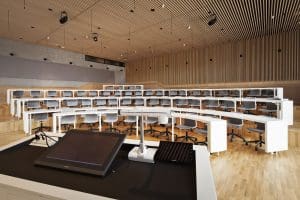One of the largest AV installation projects ever undertaken in Denmark comes off, like any AV installation worth its salt, as incredibly simple. But the Maersk building installation – an expansion of the Faculty of Health Sciences, University of Copenhagen – was no simple task.
The University had for many years suspected its Health Sciences department would soon outgrow itself. So, they launched an architectural design competition for a new building. Once the architect was chosen, it was time to consider AV.
The sheer scope of the project is astounding: 14 floors of tech were required, including large lecture rooms, study spaces, and meeting rooms. Overall, 5,000 components rounded-out a diverse group of spaces meant for as many as 900 people and as few as a handful. Over 22 kilometers – that’s over 13 miles – of cable were used in the installation.
Enter Stouenborg, the integration firm headed by Anders Jørgensen.
Maersk Building Initiatives Posed Challenges to Integrator
The University of Copenhagen Maersk building’s entire purpose rested on having a flexible, stimulating space that welcomes learning.
“It is very important that when a lecturer enters an auditorium, they do not feel limited by the technology available,” Jørgensen says. “Our goal is for the user to feel assisted by the technology they are using and are thereby free to concentrate on their teaching.”
In a tower full of presentation spaces, acoustic system integration is critical. Jørgensen and his Stouenborg firm needed to design spaces that elevate the voices of University of Copenhagen professors so the school’s students hear clearly throughout the cavernous room.
Additionally, the project had to meet strict sustainability measures, especially in the way of electricity consumption.
[related]
How Stouenborg Conquered the Maersk Building’s AV
Perhaps the pinnacle piece of technology required to meet one of the building’s most critical feature goals is the sound system.
A Meyer Sound Constellation system was installed in the Maersk building’s three large auditoriums, chosen for its “voice lifting” properties. The lecturer is heard clearly anywhere in these rooms, due to installed loudspeakers at strategic points in the ceiling. Microphones were also installed in the ceiling for the system’s other advantage: a “Q&A” mode, where students may answer questions and have their answers heard by all other attendees. The modes toggle with the touch of a button.
A central console in each auditorium features a document scanner and touchscreen computer. Anything displayed on the screen can project onto giant screens via Panasonic laser projectors.
Numerous informational screens presented with 42-inch Panasonics with Onelan players hang throughout the building, with smaller, 10-inch counterparts used to show booking for each conference room.
A Crestron Digital Media System DM 3.0 is used for the infrastructure, running 4K on input boards. Each of the three large auditoriums has a common matrix switcher on 32 x 32 lines, also connected to other matrices. This allows important lectures held in the largest auditorium to be viewed in real-time in other lecture rooms. Again aiming for simplicity of use, the integrator designed this feature to be used with a simple swipe on a touch screen or a panel installed in each lecture room.
All of this hardware needs a place, of course, and Jørgensen says the bulkier items are stored in machine rooms placed in the center of the ground floor. Before installing the systems in those rooms, Stouenborg made a mock-up space at their headquarters, where they tested the systems extensively.
Each and every cable has its own individual report and certification, meaning less cable faults and an easier time tracing faults that do occur.
Impact: Setting the Space for Crucial Health Research
The $225 million addition to the University of Copenhagen Panum Institute is occupied by some of the brightest minds in contemporary medical science.
To ensure they receive the best performance out of their learning space, Stouenborg evaluated every installed component in their testing space before transferring them into the Maersk building. The integrator used focus groups to test potential technology choices before finalizing those decisions.
“There is no doubt that user friendliness and safety is paramount,” Jørgensen says. “The auditoriums are very complex, and one of the most high-tech sound systems available makes ease of use extremely important.”
“The dream scenario is to have a lecture where everyone is free of technical limitations.”
[inpagepromo]
Stouenborg’s Maersk Building Equipment Highlights
- Meyer Sound Constellation system
- Panasonic laser projectors
- Crestron Digital Media System DM 3.0











